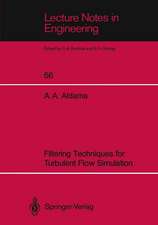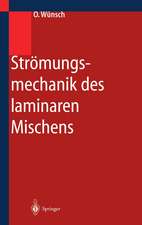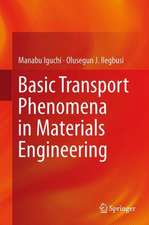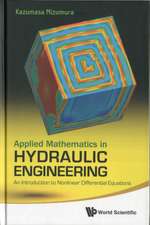Implementation of Finite Element Methods for Navier-Stokes Equations: Scientific Computation
Autor F. Thomasseten Limba Engleză Paperback – 12 dec 2012
Din seria Scientific Computation
- 18%
 Preț: 1021.05 lei
Preț: 1021.05 lei - 18%
 Preț: 743.27 lei
Preț: 743.27 lei - 18%
 Preț: 889.75 lei
Preț: 889.75 lei - 18%
 Preț: 1108.51 lei
Preț: 1108.51 lei -
 Preț: 387.96 lei
Preț: 387.96 lei - 20%
 Preț: 902.04 lei
Preț: 902.04 lei -
 Preț: 400.85 lei
Preț: 400.85 lei -
 Preț: 386.61 lei
Preț: 386.61 lei - 15%
 Preț: 654.62 lei
Preț: 654.62 lei -
 Preț: 380.25 lei
Preț: 380.25 lei - 18%
 Preț: 1111.34 lei
Preț: 1111.34 lei -
 Preț: 452.62 lei
Preț: 452.62 lei -
 Preț: 389.31 lei
Preț: 389.31 lei - 18%
 Preț: 950.03 lei
Preț: 950.03 lei - 15%
 Preț: 649.22 lei
Preț: 649.22 lei - 18%
 Preț: 787.26 lei
Preț: 787.26 lei - 18%
 Preț: 942.63 lei
Preț: 942.63 lei - 15%
 Preț: 505.18 lei
Preț: 505.18 lei -
 Preț: 389.70 lei
Preț: 389.70 lei - 15%
 Preț: 653.00 lei
Preț: 653.00 lei - 18%
 Preț: 957.44 lei
Preț: 957.44 lei - 15%
 Preț: 653.98 lei
Preț: 653.98 lei - 15%
 Preț: 643.99 lei
Preț: 643.99 lei - 15%
 Preț: 649.39 lei
Preț: 649.39 lei -
 Preț: 388.13 lei
Preț: 388.13 lei - 18%
 Preț: 958.38 lei
Preț: 958.38 lei - 18%
 Preț: 1129.52 lei
Preț: 1129.52 lei - 18%
 Preț: 967.56 lei
Preț: 967.56 lei - 15%
 Preț: 700.75 lei
Preț: 700.75 lei -
 Preț: 401.03 lei
Preț: 401.03 lei - 15%
 Preț: 597.99 lei
Preț: 597.99 lei -
 Preț: 385.62 lei
Preț: 385.62 lei -
 Preț: 394.87 lei
Preț: 394.87 lei -
 Preț: 385.08 lei
Preț: 385.08 lei - 18%
 Preț: 1106.63 lei
Preț: 1106.63 lei - 15%
 Preț: 504.17 lei
Preț: 504.17 lei - 15%
 Preț: 596.36 lei
Preț: 596.36 lei - 15%
 Preț: 653.98 lei
Preț: 653.98 lei
Preț: 381.00 lei
Nou
Puncte Express: 572
Preț estimativ în valută:
72.93€ • 79.24$ • 61.30£
72.93€ • 79.24$ • 61.30£
Carte tipărită la comandă
Livrare economică 21 aprilie-05 mai
Preluare comenzi: 021 569.72.76
Specificații
ISBN-13: 9783642870491
ISBN-10: 364287049X
Pagini: 172
Ilustrații: VIII, 164 p. 9 illus.
Dimensiuni: 155 x 235 x 15 mm
Greutate: 0.25 kg
Ediția:Softcover reprint of the original 1st ed. 1981
Editura: Springer Berlin, Heidelberg
Colecția Springer
Seria Scientific Computation
Locul publicării:Berlin, Heidelberg, Germany
ISBN-10: 364287049X
Pagini: 172
Ilustrații: VIII, 164 p. 9 illus.
Dimensiuni: 155 x 235 x 15 mm
Greutate: 0.25 kg
Ediția:Softcover reprint of the original 1st ed. 1981
Editura: Springer Berlin, Heidelberg
Colecția Springer
Seria Scientific Computation
Locul publicării:Berlin, Heidelberg, Germany
Public țintă
ResearchCuprins
Notations.- 1. Elliptic Equations of Order 2: Some Standard Finite Element Methods.- 1.1. A 1-Dimensional Model Problem: The Basic Notions.- 1.2. A 2-Dimensional Problem.- 1.3. The Finite Element Equations.- 1.4. Standard Examples of Finite Element Methods.- 1.5. Mixed Formulation and Mixed Finite Element Methods for Elliptic Equations.- 2. Upwind Finite Element Schemes.- 2.1. Upwind Finite Differences.- 2.2. Modified Weighted Residual (MWR).- 2.3. Reduced Integration of the Advection Term.- 2.4. Computation of Directional Derivatives at the Nodes.- 2.5. Discontinuous Finite Elements and Mixed Interpolation.- 2.6. The Method of Characteristics in Finite Elements.- 2.7. Peturbation of the Advective Term: Bredif (1980).- 2.8. Some Numerical Tests and Further Comments.- 3. Numerical Solution of Stokes Equations.- 3.1. Introduction.- 3.2. Velocity—Pressure Formulations: Discontinuous Approximations of the Pressure.- 3.3. Velocity—Pressure Formulations: Continuous Approximation of the Pressure and Velocity.- 3.4. Vorticity—Pressure—Velocity Formulations: Discontinuous Approximations of Pressure and Velocity.- 3.5. Vorticity Stream-Function Formulation: Decompositions of the Biharmonic Problem.- 4. Navier-Stokes Equations: Accuracy Assessments and Numerical Results.- 4.1. Remarks on the Formulation.- 4.2. A review of the Different Methods.- 4.3. Some Numerical Tests.- 5. Computational Problems and Bookkeeping.- 5.1. Mesh Generation.- 5.2. Solution of the Nonlinear Problems.- 5.3. Iterative and Direct Solvers of Linear Equations.- Appendix 2. Numerical Illustration.- Three Dimensional Case.- References.

















